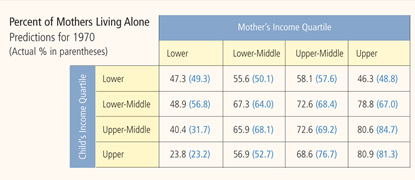“On the Living Arrangements of Elderly Widows,”1 is an unusual title for an economics research paper. Widows tend not to get much attention, as a rule, and “living arrangements” sounds so commonplace. But as Minneapolis Fed consultant José-Víctor Ríos-Rull and his co-author, Carlos Bethencourt of the Universidad de La Laguna, write in their recent paper, “The living arrangements of the elderly shape how [retirement and health care] benefits translate into the quality of life. We think that understanding those arrangements is a prerequisite for informed policy making.”
Minneapolis Fed consultant Victor Rios |
To improve that understanding, Ríos and Bethencourt look at income levels and living arrangements of families in a base year, 1970, and a follow-up year, 1990. By examining changes over the 20-year period, the economists gauge whether income is a significant or trivial factor in family |
decisions about whether a mother will live with her children once her husband dies, or live alone.
“Many people have this idea that a good chunk of the changes in the way we live over the last 50 years are cultural changes,” explains Ríos in an interview. “The problem is, we have no idea what triggers them. So we wanted to see if to some extent some of these changes that we normally attribute to cultural factors are rooted in things like the constraints that individuals face.” And in particular, income constraints.
First, the economists construct a database of family members. But because U.S. Census Bureau figures look only at family members living in the same household, and the economists want to understand family decisions to live apart as well as together, they need to construct pairs of mothers and children who don’t live under the same roof. To do so, they use data from a special survey, the 1993 Asset and Health Dynamics study, which does link such mothers and children, and then they assume that joint income distribution patterns across generations are the same in 1970 and 1990 as in 1993 (an assumption based on separate research that finds constant parent-child income correlations over the past 30 years). The result is a database of over 30,000 mother-child pairs in 1970 and over 50,000 in 1990, with full information on income and living situations.
Home alone
In 1970, the percentage of widows living in institutions or with nonfamily members was about 15 percent. Of the remaining 85 percent, nearly two-thirds of elderly widows lived alone.
By breaking the 1970 data down by income quartiles for both children and widows living alone, the economists find that the main pattern is that “more income tends to increase the fraction of widows that live alone.” A representative example: The mothers of children in the upper income quartile show a clear trend of living alone if they themselves have higher income. Only 23 percent of these widows live alone if they are in the lowest income quartile; 81 percent do if they’re in the highest income quartile.
 But the pattern is not universal. “For poor mothers,” note the economists, “the higher the income of their children, the less likely it is that the widows live alone.” And for poor children, the income of the mother has little effect on her living arrangement: “It displays a skewed inverted U shape,” they write. The fact that the patterns are not consistent is what makes the problem of understanding the relationship between income and living arrangements both difficult and interesting. “Their strong non-linearity,” observe Ríos and Bethencourt, is what “the estimated models will try to replicate.”
But the pattern is not universal. “For poor mothers,” note the economists, “the higher the income of their children, the less likely it is that the widows live alone.” And for poor children, the income of the mother has little effect on her living arrangement: “It displays a skewed inverted U shape,” they write. The fact that the patterns are not consistent is what makes the problem of understanding the relationship between income and living arrangements both difficult and interesting. “Their strong non-linearity,” observe Ríos and Bethencourt, is what “the estimated models will try to replicate.”
Twenty years later
By 1990, “things had changed quite dramatically.” Incomes—adjusted for inflation—had grown by 55 percent. For widows the jump was particularly dramatic, a 107 percent increase versus the 52 percent increase for their children. So while widows in 1970 had about a fifth as much income as their children, in 1990 they received nearly a third as much. “All the ladies got a massive increase in pensions,” notes Ríos, referring to increases in Social Security benefits.
The other dramatic shift: Far more widows are living on their own in 1990. The fraction of widows living in institutions or with nonfamily remained at 15 percent; but of the remaining 85 percent, the percentage of widows living alone jumped from 62 percent in 1970 to over 75 percent in 1990.
By again breaking down the data by income quartiles, the economists find that there had been an increase in the fraction of widows living alone in all income groups, but not in the same proportion. “For groups with the poorest mothers and richest children, the fraction of mothers living alone more than doubled,” write the economists, from 23.2 percent to 67.1 percent of all widows (including those in institutions or not with family). “The increase was less dramatic for the groups consisting of mothers with higher income.” For example, 81 percent of upper-income widows with upper-income children lived alone in 1970, and 91.5 percent lived alone 20 years later, just a 10 percentage point increase.
“The shape of the relation is very similar to that of 1970: more income implies more mothers living alone,” write the economists. But there are differences in patterns. For widows in the second quartile in 1970, for instance, there was an inverted U pattern of the fraction living alone as their children’s income increased—from 50 percent to 64 percent to 68 percent and then down to 53 percent. In 1990, however, there is a strictly increasing relation—the fraction climbed from 59 percent to 80 percent. The relationship between income and living arrangements is clearly not a simple one.
A model relationship
Building an economic model that can accurately account for these patterns is a significant challenge precisely because of the nonlinearity in each time period and the changing nonlinear patterns over time.
To build such a model, Ríos and Bethencourt describe the decision-making process about whether to live alone or together as the outcome of a “game” between mother and child. Does the mother really want to live with one of her children? What factors influence her decision? Her income? Their income? Help with errands? Privacy? How about the child—what factors play a role in deciding whether to set mom up in the spare bedroom? Does the spouse have an influence? Would mom be a financial burden or a cushion?
In modeling this game mathematically, one equation represents a widow’s utility function and another is the child’s utility. The equations take into account each person’s income, economies of scale in living together, direct preferences about living alone or together (favoring autonomy versus companionship, for instance), levels of effort expended and risk aversion. Solving the equations together provides the solution to the game: the living arrangement that provides an equilibrium of joint utility.
And while the word “game” implies that each party hopes to “win”—that is, shape the outcome in the direction that party favors—the economists also build a variation of the model that “considers the possibility” that mothers and children are altruistic toward one another—a person’s utility function includes the other person’s utility. Indeed, the economists consider nine different models, but settle on one that provides a good fit to the data, with as few explanatory factors as possible. And indeed, the fit they find is remarkably accurate.
The economists’ baseline model with seven parameters matches the 1970 data with 88.5 percent accuracy—meaning that nearly 90 percent of the actual variance in living arrangements is accounted for. The table below shows the predictions of this model for each mother-child income quartile in 1970 alongside the actual data, describing 16 cells (= 4 mother income quartiles × 4 child income quartiles). So, for example, the model predicts that 58.1 percent of widows in the third quartile (upper-middle) whose children are in the first quartile (lower) will live alone, close to the actual figure in 1970 of 57.6 percent.
Understanding mothers
Model in hand, the economists use it to assess the role that changes in income between 1970 and 1990 played in determining the shift in living arrangements over that same period. Was the shift toward independently living widows a massive cultural change, as popular thought might have it, with children abandoning their parents? Or did economics play a leading role by enabling widows to live on their own?
Using 1990 income data, the economists’ baseline model generates a prediction that 71.9 percent of widows live alone, a near match to the actual figure of 75.3 percent. For the same mother-child income quartile described above for 1970 (widows in the third quartile whose children were in the first), the model predicts that 65 percent will live alone in 1990 while the actual figure was 63 percent, an almost perfect fit.
The economists calculate, then, that shifts in income alone (that is, aside from cultural forces) for both widows and children were responsible for nearly three-quarters of the change in living arrangements. (More precisely, their estimate is 74.4 percent, the ratio of the 15.97 percent increase in widows living alone predicted by the model to the 21.45 percent actual increase.)
That finding alone is substantial. But the beauty of the Ríos-Bethencourt model is that it allows the economists to explore nuances of the income-family-living- arrangement matrix, providing dimensions beyond a simple “income shifts explain most of the increase.” And the nuances are a bit startling.
“We have found that mothers prefer living alone,” write the economists, and “are less risk averse than their children.” And while children, too, prefer to live on their own, “the estimates for the economies of scale imply that mothers are welcome because their income is large relative to their consumption requirements.” If a mother’s income is at least 2 percent of a child’s own income, the economists calculate, the child will be inclined to invite her in. “All in all, typically children undertake effort to live together while the opposite is true for mothers,” they conclude.
The model also allows the economists to “decompose,” or apportion, the relative influence of various types of income, and they parse it in great detail, looking at averages, medians, dispersions, absolute levels and comparative levels. Two bottom lines from this analysis:
- The increase in widows’ income accounts for two-thirds of the total 75 percent increase in widows living alone, while the increase in children’s income by itself actually reduces the fraction. It is the combined effect of mother and child income increases that brings the total change up to 75 percent, “reflecting the highly non-linear relation,” they write, “between incomes and living arrangements.”
- The increase in absolute levels of income accounts for only a quarter of the changes in living arrangements; the change in relative income between mothers and children explains the other half.
Mothers-in-law
Of course, income is not the only factor that might have an influence on mother-child decisions about whether to live together. The economists explore other characteristics. Neither the number nor the gender of children has any obvious relationship to the choice of living arrangements, they find. The age of the children does have an influence; the younger the average child, the less likely the mother will live alone. Mothers stay with the youngest child 42 percent of the time and with the oldest just 23 percent of the time.
But it is the child’s marital status—aside from income—that appears to have the greatest influence on living arrangements. In the 1970 database, 57 percent of mothers are paired with a married child and the remaining 43 percent with a single child. Nearly 71 percent of those widows paired with married children live alone, higher than the 50 percent for widows paired with single children. But by 1990, as incomes rose, there was a greater increase of widows living alone for the latter group, rising from half of widows to two-thirds, while the widows paired with married children increased more modestly from 71 percent to 86 percent, still significantly higher than for single children.
The economists modify their basic model to incorporate the child’s marital status. Again, for both mothers and children, parameters reflect consumption, effort expended, utility from living together, economies of scale and the like. Equilibrium is achieved through a “game” between mother and child.
The model estimates the 1970 data with 93 percent accuracy for mothers with a married child and 88 percent for those with a single child, and it replicates key facts—the richer the mother, the more likely she lives alone whether or not her child is married; the richer the child, the more likely he or she lives with the mother if married, but less likely if single.
The economists note several curious findings. The effort of living with one’s mother is much more costly for married children than singles, “reflecting perhaps the involvement of a spouse.” And it turns out that “the mother does not like to live with her married child but that she does indeed like to live with her single child,” this despite the fact that the share of total household consumption devoted to mothers is bigger in households with married children than in those with singles.
The most striking finding, though, comes from the model’s predictions for 1990. For all but one mother-child income quartile, the model provides an excellent fit, and it attributes just 52 percent of the increase in widows living alone to income shifts, down significantly from the 74 percent attributable to income in the model without marital status. Income clearly counts—more than other factors—but it’s not the only issue at play when widows and their children decide whether to live together.
Culture counts
So, aside from income and marital status of the child, what explains the remainder of the dramatic shift toward widows living alone? “I could tell you the obvious two answers,” responds Ríos. “One of them, of course, is that life is a lot more complicated than these little things that we put in the model. But also, I think this is where culture counts.”
As more people engage in a certain activity or live in a particular fashion, they form a community of sorts—a group or network whose members interact with one another and reinforce that shared identity or interest. “If changes in prices or income cause people to change what they do, once there are more people doing it, it becomes more attractive,” observes Ríos. “So if there are more ladies living alone, they can have more fun; it’s more rewarding to live alone than before. That’s what culture may do; it may partly cause an amplification from the actual change.”
Referring to work by economists such as Alessandra Fogli and Raquel Fernández on fertility, labor force participation and culture, he notes that economics interacts with culture to create change in people’s lives. “It’s partly culture, but not culture as independent of economics,” he says. “It is culture rooted in economics, which is what I think, as economists, we want to make sense of. We don’t want an enormous separation between what other social scientists do and what we do. We want to have a joint appreciation of things.”
1 To be published in August 2009 in the International Economic Review.
See: “The Labor of a Renaissance Man.”







